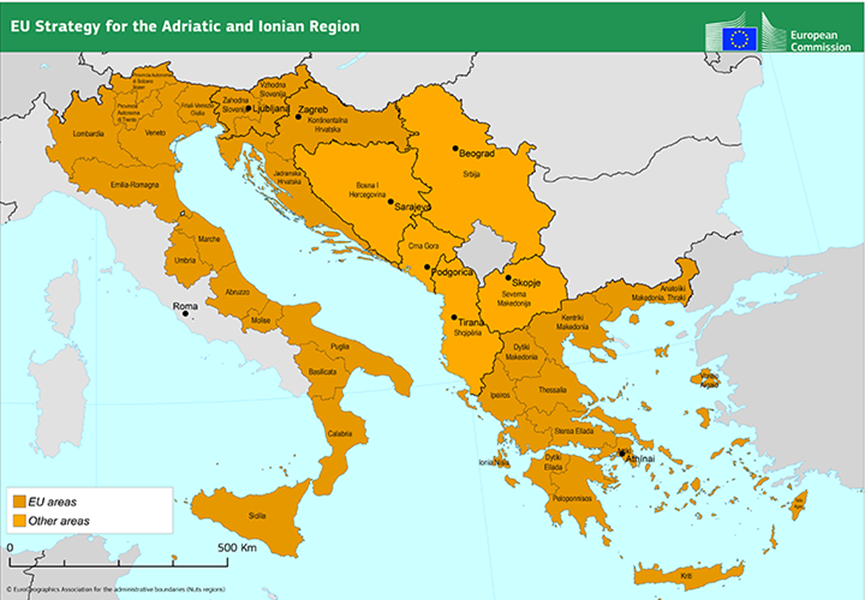The third newsletter of our company includes news related to our completed projects and activities in the context of our ongoing projects.
COMPLETED PROJECTS
Evaluation support study on the impact of the CAP on territorial development of rural areas. Socioeconomic aspects: final report
The evaluation support study, financed by the European Commission, was carried out by ADE SA (Framework project leader). LKN ANALYSIS Ltd was the national expert for the Peloponnese case study.
| The main focus of the study is on territorial development of rural areas, which are investigated through the analysis of socio-economic aspects and social inclusion. The evaluation work starts with a causal analysis which intended to scope and select the CAP measures and instruments considered to have a direct impact on the general objective of BTD in rural areas. The work is then articulated around five evaluation criteria: effectiveness, efficiency, coherence, relevance, European added value. Several methods have been applied to gather and analyse both quantitative and qualitative information. Sixteen evaluation study questions have been answered by using quantitative methods such as input-output analysis, clustering, and statistical regressions, as well as qualitative methods, including case studies, literature review and the observation of development trends over the programming period. According to the evaluation study findings, the issues and needs faced by rural regions in the EU-28 are significant. The evaluation’s quantitative and case study findings indicate that the impact of the CAP in supporting BTD through the improvement of socio-economic aspects and social inclusion varies according to the characteristics of the rural region and the policy mix applied. Pillar I instruments, in particular direct payments, have been found to positively impact regional employment and re-investment. Pillar II measures, some of which are specifically designed to address socio-economic issues, demonstrate also positive effects. Full report (in English): https://ec.europa.eu/info/food-farming-fisheries/key-policies/common-agricultural-policy/cmef/rural-areas/impact-cap-territorial-development-rural-areas-socioeconomic-aspects_en |
IN PROGRESS
EUSAIR Pillar 1 “Blue Growth” Monitoring and Evaluation Consultant
Contracting Authority: EUSAIR Facility Point Greece (Ministry of Development and Investments, Special Service for Strategy, Planning and Evaluation, Greece)
The project was assigned in 2019, following an international call for tenders, to the consortium comprising LKN ANALYSIS Ltd and the University of the Aegean (Greece). The scope and objectives of the project is the monitoring and evaluation of the progress achieved in EUSAIR Pillar 1 “Blue Growth”. Furthermore, the Pillar 1 Monitoring and Evaluation (M&E) Consultant has a coordinating role among the M&E Consultants of the other EUSAIR Pillars.
The project includes three main activities, namely:
Activity 1: Building the Knowledge Base (KB) relevant to Pillar 1 “Blue Growth”
Activity 2: Establishing the EUSAIR Monitoring and Evaluation Framework
Activity 3: Capacity building for public authorities / administrations
Activity 1: Building the Knowledge Base (KB) relevant to Pillar 1 “Blue Growth”
Building the necessary Knowledge Base involves: (a) an inventory of existing resources (already concluded or on-going studies or research, existing databases at regional, national or European level and available statistics), and (b) the implementation of a Pillar- related study.
Task 1: Inventory of existing resources at Pillar level
The Pillar 1 Knowledge Base comprises data from three different sources, namely: i) studies relevant to the EUSAIR Pillar 1 strategy, ii) databases developed by international organisations including Blue Growth relevant data, and iii) statistics from various international and national sources. In particular:
- 83 relevant studies have been identified. The relevant studies inventory was developed according to an extended literature review and the collection of relevant information from the EUSAIR countries. All of the studies were processed and an informative fiche for each study and relevant tables were produced.
The identification of the relevant databases followed a detailed desk research, attempting to highlight which databases could provide information on the Pillar 1 topics and priorities were further exploited allowing a detailed presentation. 11 Databases have been identified and exploited and, in addition, the ESPON European and Macro-Regional Territorial Monitoring Tool.
The relevant statistics are presented in two groups: i) Group A: Data Set A1: Fisheries & Aquaculture, Data Set A2: Research & Innovation, and, ii) Group B: Socio-economic indicators and other statistics relevant to the Adriatic – Ionian macro-region.
An executive summary of the Pillar 1 Knowledge Base was delivered to the Pillar 1 Thematic Steering Group (TSG) members in September 2020.
Task 2: Pillar 1-related study
The overall objective of the study is the identification of important information gaps, needs and opportunities to facilitate and foster the design and implementation of EUSAIR flagship actions and projects in the Adriatic – Ionian macro-region (Acronym: Ideal EUSAIR).
The topic/object of the study was approved in the 11th virtual meeting of Pillar 1 Thematic Steering Group (July 15th, 2020).
The IDEAL EUSAIR study:
- Reviews and updates the current status quo in relation to the Blue Growth identified flagships;
- Sets up a comprehensive inventory of existing Blue Growth-related stakeholders representing the quadruple helix ties in the EUSAIR area;
- Elaborates the SWOT analysis of EUSAIR Pillar 1, deepening the analysis per topic and country, whereas feasible;
- Proposes categories of project ideas;
- Proposes a list of indicative/potential Blue Growth-related projects that could be implemented in the new programming period, taking into account the wider context of the European Blue Growth policy, the new ESIF regulations, the Cohesion policy and other funding mechanisms and the EUSAIR approved flagships for the programming period 2021-2027.
The study was delivered by end of February 2021.
Activity 2 : Establishing the EUSAIR Monitoring and Evaluation Framework
Task 1: Set up of the EUSAIR Monitoring & Evaluation System
The proposed EUSAIR Monitoring & Evaluation System is expected to cover gaps and weaknesses in the monitoring process of the macro-regional Strategy, mainly regarding the information flows between the TSGs and Pillar stakeholders, public authorities in the EUSAIR countries and other bodies involved in the implementation of the Strategy. The proposed Monitoring & Evaluation System:
Is based on the existing monitoring structures of the European Structural and Investment Funds and IPA programmes (including European Territorial Cooperation programmes).
Defines the requirements for information and draws up the respective information flows, from the project beneficiaries to the management information systems (MIS) of the EU member states and the authorities in charge for reporting on the implementation at Pillar and EUSAIR levels.
Defines the requirements for extracting information from the IPA countries in order the reporting to be feasible and efficient.
Describes the requirements for information regarding the implementation of projects under EU directly managed calls and the process in order that information to be useful for the Pillar and EUSAIR implementation reporting.
Presents a flowchart describing the whole monitoring process from the level of beneficiaries to the integrated reporting, including the assignment of specific tasks to all actors involved in the EUSAIR implementation; the beneficiaries, the ESIF and other programmes Managing Authorities, the IPA implementation mechanisms, the TSGs and the Pillar M&E Consultants.
Introduces the indicator system to be used: a) for monitoring the AI-R as a whole on the basis of socioeconomic and Pillar-related indicators and, b) for monitoring the implementation at Pillar level on the basis of selected output, result and impact indicators.
The Pillar 1 “Blue Growth” proposed indicator system contains output, result and impact indicators. In particular:
- Nine socio-economic context indicators;
- Six Pillar 1-related context indicators;
- 43 output indicators;
- 33 result indicators;
- Two impact indicators.
In addition, four governance indicators are proposed as procedure-based indicators, reflecting the activities of the Pillar 1 Thematic Steering Group.
Task 2: Annual Pillar Monitoring Reports
The progress of the EUSAIR’s implementation at Pillar level is presented in the Annual Pillar Monitoring Reports. The structure of each report includes the following sections:
- A short introduction on the latest developments and trends of the Blue Growth sectors in the Adriatic – Ionian macro-region, including Pillar 1 context indicators whereas feasible.
- The implementation of Pillar 1 priorities and the progress achieved in the reporting year. The Pillar relevant projects (completed or in progress) were identified under the CBC and Transnational programmes, the ESIF and IPA programmes, the EU directly managed calls and national programmes.
- The Pillar 1 monitoring indicators introduced by the proposed EUSAIR Monitoring and Evaluation System and the achievement of their target values whereas feasible.
- A summary of the latest developments at the Pillar 1 governance and coordination level including the outcomes of TSG 1 meetings and other relevant events.
- Next steps of implementation by the end of the reporting year.
Task 3: Annual Synthetic EUSAIR Monitoring Reports
On the basis of the Annual Pillar Monitoring Reports, the EUSAIR Pillar 1 Monitoring and Evaluation Consultant prepares, by end-November of each reporting year, a Synthetic Annual Monitoring Report at EUSAIR level, which presents the progress of implementation achieved in the whole of the EUSAIR. This report combines the analyses and conclusions contained in the separate Annual Pillar Monitoring Reports. The report follows the same structure with the Annual Pillar Monitoring Report.
Activity 3: Capacity building for public authorities / administrations
Capacity building for monitoring and evaluation is a crucial parameter for the success of a macro-regional Strategy such as the EUSAIR, taking into account the different levels of knowledge and practical experience in programme monitoring and evaluation between the EU and IPA Member States. In addition, different knowledge and skills are required for monitoring and evaluation at the macro-regional Strategy level compared to those required for programme monitoring and evaluation. It is, therefore, to the benefit of all EUSAIR participating countries that a number of capacity building events are envisaged in the context of WP3 of the EUSAIR Facility Point. These events are:
- Eight national capacity building events (conferences), organised by the EUSAIR Facility Point project partners.
- Two macro-regional capacity building events (conferences), organised by the lead project partner for Work Package 3 of the EUSAIR Facility Point.
So far, one macro-regional event has been organised (November 7th, 2019, Athens, Greece) focusing on the state of play of the EUSAIR FP Work Package 3 “Monitoring and Evaluation”. Guidance was provided on the preparation of the EUSAIR Pillar 1 Annual Monitoring Report 2019 and the Annual EUSAIR Synthetic Report 2019.
Due to the COVID-19 pandemic and the relevant restrictions there is no progress in the organisation of the national capacity building events.

Source: https://ec.europa.eu/regional_policy/en/policy/cooperation/macro-regional-strategies/adriatic-ionian/
